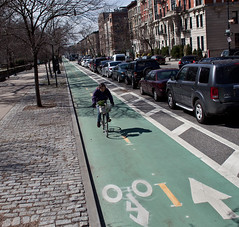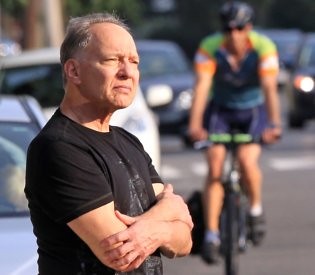Biking as a social change movement
The City Paper cover story this week about biking, "Sometimes a Bike is Just a Bike: On the symbolism—and politics—of bicycling in D.C.," doesn't really say anything new, but it is an extremely well-written article. For me, the best parts are the quotes from Andy Clarke, President of the League of American Bicyclists, as he is one of the most articulate advocates on the issue nationally.
While the article calls bike lanes an indicator of "gentrification":
There are a few easy signs that developers, real-estate brokers, new residents, city planners, and other agents of gentrification have their eyes on a particular neighborhood. A new condo building pops up, for instance. A bar suddenly seeks a change in its liquor license to set up a sidewalk patio. Or, out of nowhere one day, a bike lane gets painted on the street, like on 25th Street SE. (And, thanks to the incremental nature of the District’s bike-infrastructure projects, it not only appears out of nowhere, but it seems to lead to nowhere, ending mysteriously a few blocks down the road.)
I don't think that accurately depicts how biking infrastructure is created. The article does go on to make the point that maybe it's about car owners fighting changes.
It's because biking questions the dominant mobility paradigm of automobility, and people with cars don't like very much any perception of their giving up what they see as their "rights" (not "privileges") to the road.
By quoting Andy Clarke, the article makes a point that I do frequently, that bike lanes and other infrastructure are opposed virtually everywhere, including progressive cities like San Francisco and Portland and New York City, at least initially. From the article:
Any city moving forward with bicycle infrastructure faces a battle, according to Andy Clarke, the president of the League of American Bicyclists. Look at New York, where transportation commissioner Janette Sadik-Khan has been vilified in Park Slope (where brownstones sell for nearly $2 million) and Staten Island (a stronghold of the white ethnic middle class) alike for installing lanes. There will always be opposition to bike lanes, and Clark says it’s nearly impossible to characterize or typify those who don’t want them—save for one kind of mind-set.
“I think it’s probably fairly predictable in being that whoever feels threatened, you’re taking stuff away from. If you’re taking away parking, or a travel lane, or a street corner, or an old rail corridor, whoever feels they’re losing something is going to get bent out of shape,” he says. “You’ve got high-class opponents and areas where people have complained about bike lanes going through poor neighborhoods. I don’t think race or class or income is the issue. I think it’s fear of the unknown and fearing losing something that you’ve had is the most common denominator.”

Cycletrack, Prospect Park West in Brooklyn. Photo: Michael Kirby Smith for The New York Times.
2. This week, the Courts upheld the Prospect Park West bicycle lane in Brooklyn, which was opposed by rich people including Sen. Charles Schumer and his wife, Iris Weinshall, the former transportation commissioner for NYC who doesn't like it that one, she was succeeded by Janette Sadik-Khan, and two, that Khan has a different mobility agenda. See "Judge Rejects Groups' Effort to Remove Bike Lane" from the New York Times.

Photo by Matt Stone, Boston Herald. ‘A PREVIEW OF WHAT WILL COME’: Eric Berger stands on the edge of Massachusetts Avenue in Arlington, where the town is proposing adding more bike lanes.
3. And the Boston Herald reports in "Activist seeks to hit brakes on bike lanes," about how Arlington, Massachusetts resident Eric Berger claims he has spent $100,000 fighting the creation of bike lanes on Massachusetts Avenue. From the article:
Eric Berger claims he has spent more than $100,000 on a legal team, a civil engineer and a historian to fight Arlington’s plan to take away drivers’ lanes on both sides of busy Massachusetts Avenue and designate them . . . bike-only.
“And I’m not a wealthy guy,” the car-rights activist said. “People are saying, ‘Why are you doing that?’ It surprised me. I’m doing it because to me this is an example of government waste at its worst.”
Call him an internal-combustion-engine hugger, but Berger worries reducing travel lanes to make way for bike lanes will create traffic jams, hurt local businesses and jeopardize public safety. ...
Berger noted the heavily used Minuteman Bike Path already runs the length of town. A Toyota Camry driver, he rides a bike and insists he’s no hater. But he said he’s convinced pro-bike extremists are intent on creating a “cycling utopia,” and warned if you give them a lane, they’ll take the whole road.
“What’s happening in Arlington is a preview of what will come elsewhere,” he said.
For the most part he's wasting his money. Generally, by increasing bike traffic and reducing automobile traffic, especially in denser areas, mobility throughput is improved.
But automobility advocates refuse to be data-driven, because the data is not favorable to their position.
4. This letter to the editor in the Seattle Times captures the automobility sentiment perfectly:
Automobile Mondays
How considerate of the city to provide bicyclists exclusive use of a major street for five days each year so they may cruise down Lake Washington Boulevard “without having to worry about cars competing for the roadway” [“Bicycle Sunday: No cars allowed,” Your Thursday, Aug. 18].
I thought the endless, expensive, everyday Burke-Gilman Trail was built just for that purpose.
If Cascade Bicycle Club members — who don’t pay a penny for the right to pedal over roads — are granted this luxury, how about rewarding motorists — who must pay for the privilege with car and drivers licenses, insurance and ever-increasing license-tab fees — with a few bike-free days on selected Seattle thoroughfares?
“Automobile Monday: No bikes allowed” has a nice ring to it.
— Dean Trier, Redmond
a. Note the use of the word "right" to refer to use of the road.
b. Most drivers believe that somehow, their gas taxes and registration fees pay for all of the roads. Nope, especially for local roads. On average, 50% of the cost of roads comes from general funds, not "user fees and taxes."
c. Fwiw, if the average car is driven 12,000 miles/year and gets 22 miles/gallon, the person would use about 545 gallons of gas each year. With state and federal gasoline taxes, the total expenditure on gas taxes would be about $310, which doesn't pay for much.
d. Bicyclists likely pay as much or more as anyone else for the road network.
5. Washcycle's piece on the City Paper article, "Bike lanes, race and politics in DC," has some good comments about how it is fact that a clear majority of people in DC bicycling are white. I made this (edited) comment:
WRT biking being a whitey phenomenon, while I would argue it is somewhat bimodal (very poor, especially Hispanics, and people with money), this isn't a surprise.
Social change/Behavioral change (and the early adoption of new behaviors and attitudes) tends to be a function of economic status and educational attainment.
Just as I argue that African-American perceptions about the value of urban living lag more recent trends that favor urban living, it shouldn't be a shock that the same goes for sustainable transportation, in particular biking.
People talk about bicycling "culture" but I argue against the belief that somehow there is some kind of bicycling culture that makes Portland or Copenhagen unique.
Culture is constructed. In those places, they've made many decisions, both over the years, and in a complementary fashion, to support sustainable transportation at the expense of automobility.
For cities, this makes sense, because cities were created to optimize mobility on foot, by bike, and on transit.
The problem in most U.S. places is that policies aren't complementary. E.g., in Amsterdam I think, it takes two years to get a parking permit to be able to park your car in the core of the center city. And it isn't cheap.
In DC, the cost for a residential parking permit is $15/year.
Similarly, gasoline excise taxes are so much higher in Europe, which not only discourages driving, but "encourages" new development to be located and designed in a way that minimizes driving.
These kinds of differences between the U.S. and European countries when it comes to transportation policy make it much more difficult to induce mode shift to biking more rapidly here, especially because biking infrastructure is usually constructed not in terms of demand and the likelihood of use, but on the basis of what road reconstruction projects are happening. While this is done to minimize costs, it makes it harder to show significant gains in a timely fashion.
6. The always great urban design writer for the Toronto Star, Christopher Hume, has a piece comparing Quebec and Ontario as it relates to biking, "What goes around in Quebec comes around in Ontario."
From the article:
If you haven’t been to Quebec in a while, prepare to share the roads — and even more amazingly, the highways — with the two-wheeled. Everywhere you turn now, bicycles are part of the traffic mix. In addition to separated lanes in Montreal, highways are marked and divided into bike lanes and vehicular lanes. Even routes that aren’t marked have signs that make it clear the two — bikes and cars — must share the road.
In Toronto, by contrast, bikes have become a cause for panic, a wedge issue exploited by elected leaders for their own benefit. It is a topic on which municipal elections can be won or lost, at least in part. That’s not entirely new, of course, but it is another indication of how the politics of Ontario — and Toronto — are becoming sclerotic. So frightened are we of change that we buy into the promise that the province’s glorious yesterday will never end.
It already has.
Who could forget Mayor Rob Ford’s first utterance upon being elected last November? “The war on the car,” he said, “is over.”
Such silliness. Regardless of what His Worship may think, the war of the car has only just begun. Whether or not Torontonians realize it, we will be seeing many more bikes on the streets here and around the world.
This isn’t a matter of right or left, but of right and wrong. Due to circumstances well beyond the city’s control, this is the direction we are headed. For any number of reasons — climate change, fuel costs, congestion and diminished resources — the heyday of the car is over and alternatives are needed.
Unlike Ontario, Quebec has embraced change, and turned it to its own advantage. Anyone travelling through rural Quebec will find the roads alive with cyclists. Look in the parking lots of the auberges, hotels and inns; they are full of bikes.
The issue is whether or not you want to be the change, lead the change, or be behind.
Labels: bicycling, car culture and automobility, change-innovation-transformation, protest and advocacy, transportation planning, urban design/placemaking



1 Comments:
Thanks for the guide. this information help me my store online medicine website How to seo.
Post a Comment
<< Home